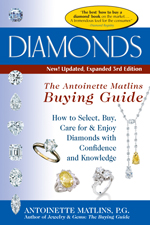FOR IMMEDIATE RELEASE Contact: publicity@gemstonepress.com |
|
AMIDST GIA SCANDAL, NEW BOOK OFFERS SPARKLING INSIGHTS INTO BUYING DIAMONDS Anyone buying a diamond today has cause for concern. While there are many wonderful, new developments that offer exciting new choices—new shapes, new colors, new setting styles—there are also more reasons to be leery. There are more laboratory-created diamonds in the marketplace than ever before, and high-tech treatments are altering the color and clarity of inferior quality diamonds to transform them into stones that appear more rare and desirable. New diamond imitations, such as moissanite, are being misrepresented and sold as diamond. Diamonds sold on the Internet are often accompanied by misleading “laboratory reports” or “appraisals” from fraudulent laboratories, or use counterfeit reports issued by the Gemological Institute of America (GIA). And all of this at a time when the Gemological Institute of America, which created the world’s premier gem-testing and diamond-grading laboratory, finds itself in the midst of a major scandal involving the over-grading of several important diamonds. If you can’t rely on the GIA, who can you trust? What can consumers do to ensure they know what they’re getting and that they are paying the right price? According to Antoinette Matlins, P.G., diamond expert and author of the newly released book, DIAMONDS, 3rd Edition: THE ANTOINETTE MATLINS BUYING GUIDE (GemStone Press / June 2011 / Quality Paperback Original / $18.99), consumers need to understand that it is a mistake to rely on a diamond grading report alone, regardless of the laboratory issuing the report. The extensive use of reports, especially those issued by the GIA, has been both a blessing and a curse. On the one hand, it has benefited consumers by reducing fraud and misrepresentation, and has enabled consumers to have greater confidence in what they buy and the price they pay. But unfortunately, since GIA reports now accompany most fine diamonds over ¾ carat, today virtually anyone can sell diamonds without really knowing anything about them. In short, diamond-grading reports have been substituted for knowledge. This is especially dangerous given the growth of non-traditional venues such as the Internet where an alarming number of fraudulent “laboratory” reports and counterfeit GIA reports are being used to lure buyers into thinking they are getting bargains when they are not. “It is especially important,” advises Matlins, “to buy only from someone who is a gemologist skilled at grading diamonds. Not only will he or she have the knowledge to double check any diamond accompanied by any laboratory report and confirm that the quality of the stone matches what is on the report, but a gemologist will also be able to accurately grade diamonds not accompanied by GIA reports, including smaller diamonds used as accent stones in rings and other jewelry settings. “It is equally important to buy from someone you can locate should you discover that anything is wrong. This may be a problem when buying from Internet vendors unless you can make arrangements to verify the facts ... before paying for the diamond. If not, don’t purchase from an Internet vendor.” WHAT’S NEW IN THE THIRD EDITION OF DIAMONDS: By Antoinette Matlins, P.G. Newly updated and expanded, Diamonds, 3rd Edition: The Antoinette Matlins Buying Guide is an invaluable source of essential information for anyone interested in diamonds, whether you are buying, selling or simply increasing your appreciation and understanding. Offering expert and practical guidance, this easy to understand book offers all the in depth information you need to buy sparkling diamonds with confidence, including:
* * * * * * * * * * * * * * * * * * * * * * * * The Antoinette Matlins 4-Step Guide to Buying a Diamond If you’re about to purchase a diamond, you’ll want to pay attention to the following tips from diamond expert Antoinette Matlins, P.G., from her newly released book, DIAMONDS, 3rd Edition: THE ANTOINETTE MATLINS BUYING GUIDE (GemStone Press / June 2011 / Quality Paperback Original / $18.99). For more information, visit www.gemstonepress.com.
If the stone has a Gemological Institute of America (GIA) report (or report from another laboratory), ask if the jeweler has graded the diamond him or herself and agrees with the grades shown on the report. Go over all of the details on the report and be sure to get the original report. If the jeweler can’t make it available at the time of the transaction, be sure to get a copy of the report to take with you. This is also very important if you are buying an unmounted diamond that the jeweler is going to mount for you. Call the GIA to confirm they have issued the report and that the information on the report matches what is in their files.
The last step is the most important. Only by finding someone with the right credentials and taking the time to have the facts verified, will you know whether or not the seller was reliable. There are many unscrupulous appraisers working in collusion with unscrupulous jewelers, especially in wholesale diamond districts around the world, so seeking someone with a respected certification is essential. If everything checks out, you’ll enjoy your purchase for years to come. If not, you’ll have what you need to get your money back, regardless of store policy. If the facts have been misrepresented, the law requires the seller to refund your money. Praise for
Diamonds, 3rd Edition: The Antoinette Matlins Buying Guide (6" x 9", 240 pp, 12 pages in beautiful full color, with over 150 color and b/w photos & illus.; index, Quality Paperback Original, 978-0-943763-73-6, $18.99) is available from Barnes & Noble, Borders, Books-a-Million, Cokesbury, Doubleday, Indigo/Chapters, Waldenbooks, B. Dalton, amazon.com, barnesandnoble.com, and many other booksellers, or directly from GemStone Press, P.O. Box 237, Woodstock, VT 05091. Tel. (802) 457-4000, Fax (802) 457-4004, www.gemstonepress.com. For credit card orders, call (800) 962-4544. Add $3.95 shipping and handling for the first book, $2.00 for each additional book. |
|
